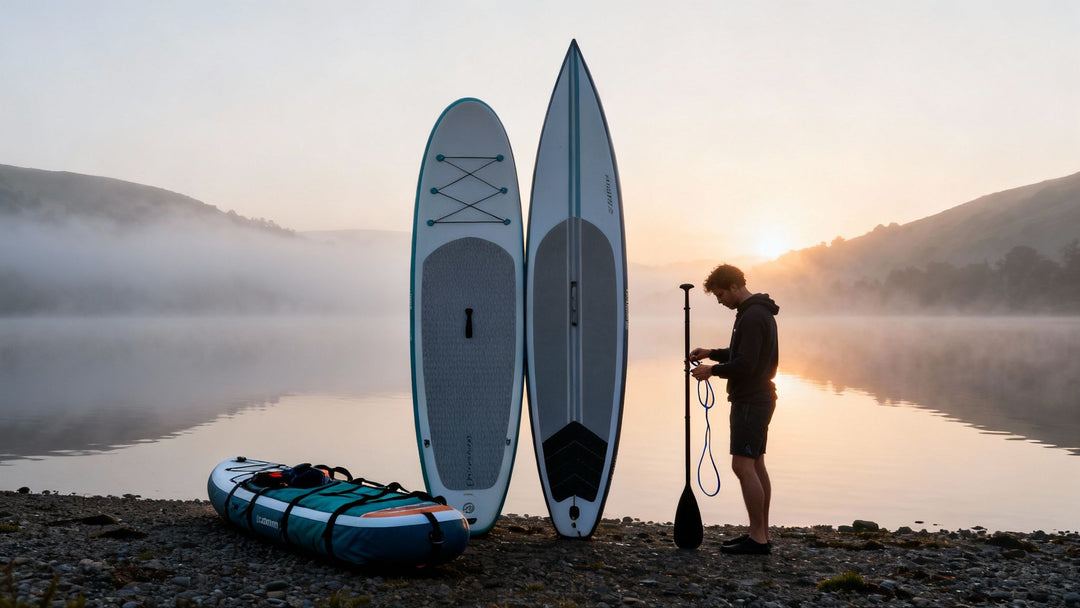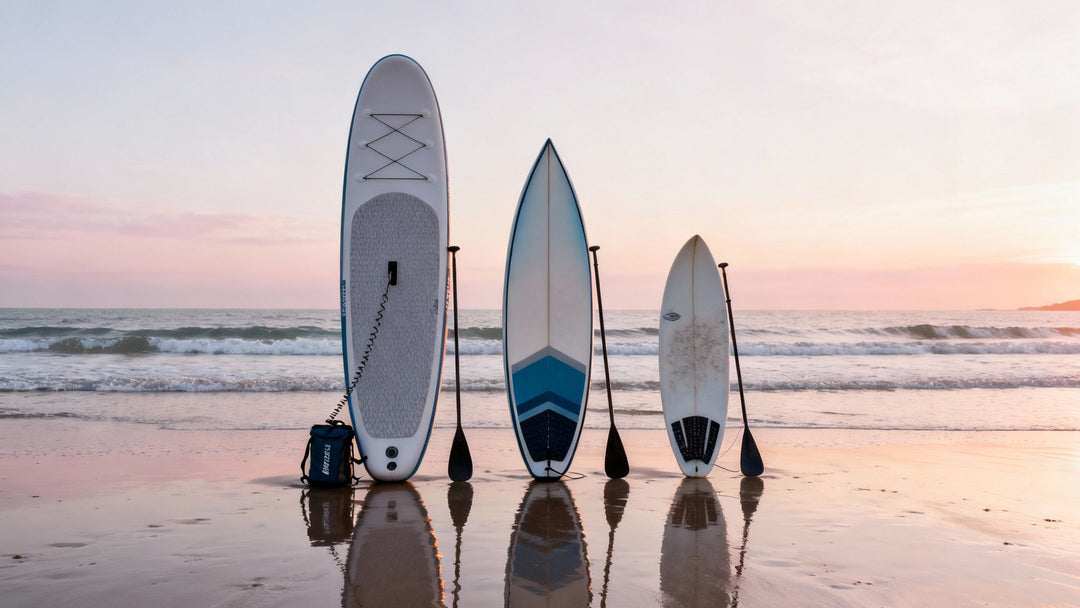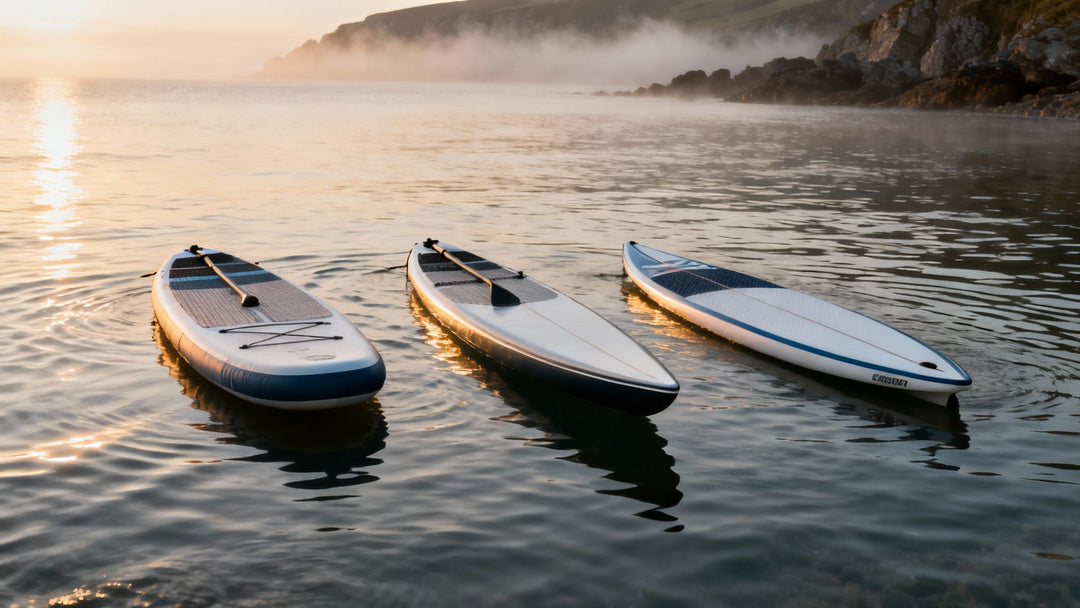How to Choose a Paddleboard: A UK Buyer's Guide
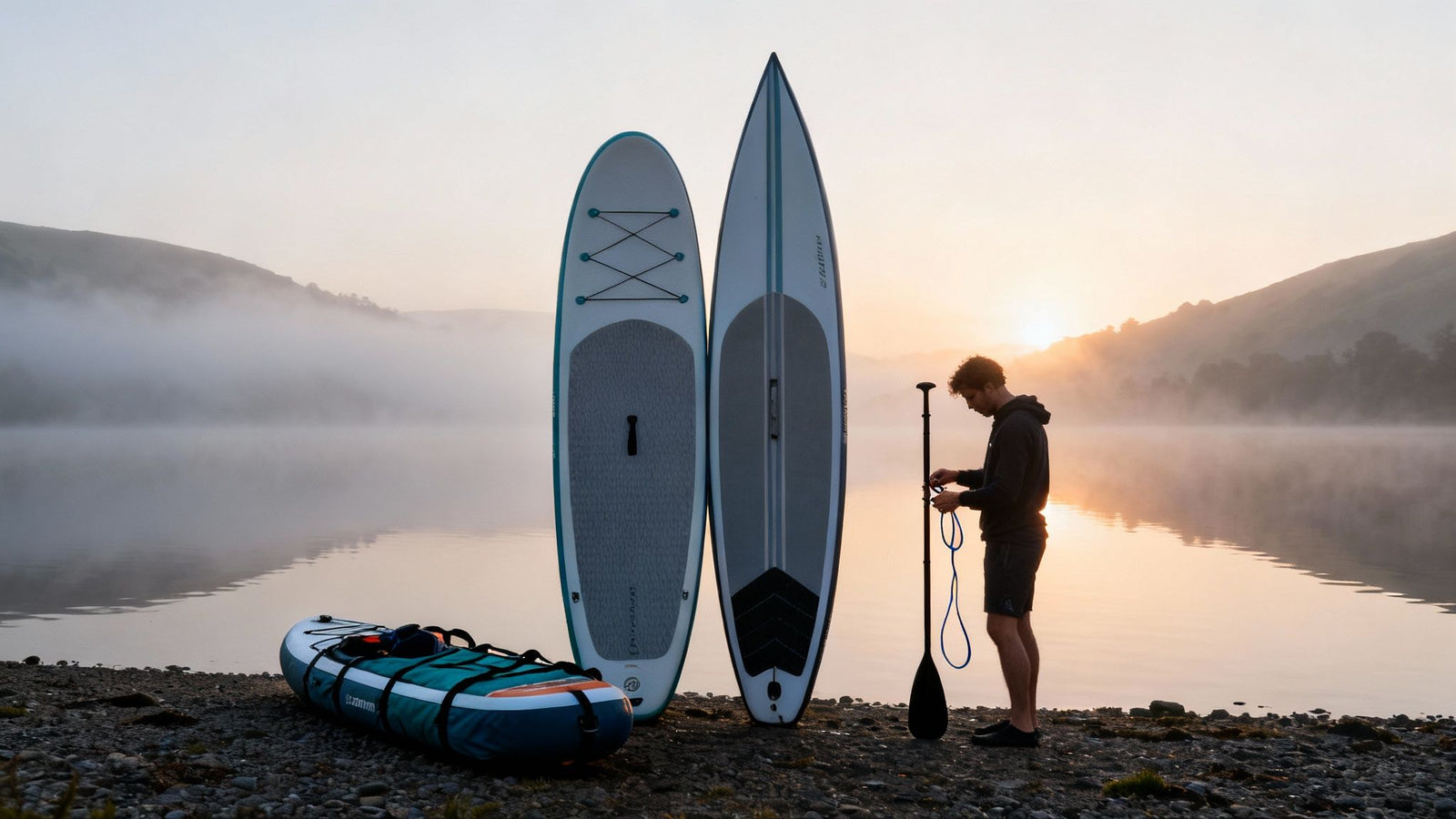
Choosing the right stand up paddleboard isn't about finding the "best" one on the market—it's about finding the best one for you. It really just comes down to a simple match-up: your skill level + where you'll paddle + what you want to do.
Get this combination right, and you'll have an incredible time on the water. Get it wrong, and you might end up with a wobbly, frustrating first experience that puts you off for good.
Finding Your Perfect Paddleboard Match
Walking into a shop or browsing online can feel like stepping into a maze of technical terms and endless options. But don't worry, you can cut through the noise by asking yourself three straightforward questions. This little bit of self-reflection will help you ignore the marketing hype and focus on what actually matters for your paddling adventures.
Think about these key areas before you even look at a board:
- Your Skill Level: Be honest. Are you a total newbie who’s never set foot on a board? Or have you got a few paddles under your belt and you're ready to step things up? For example, a complete beginner needs maximum stability, while an intermediate paddler might trade some stability for better glide and speed.
- Your Paddling Environment: Where are you going to be? Picture yourself on the water. Is it the calm, glassy lochs of Scotland, a gentle river cruise, or are you hoping to catch some small waves off the Cornish coast? A board designed for calm lakes, like the Loco Amigo Air, will feel very different in choppy sea conditions compared to a model built for waves.
- Your Primary Activity: What’s the main reason you’re getting a board? Is it for relaxed weekend paddles, trying out some SUP yoga, heading off on long-distance tours, or a bit of everything? Each activity has its own ideal board type. For example, a dedicated yoga board will be wider and more stable than a sleek touring board designed for long distances.
Solid vs Inflatable: A Core Decision
One of the very first choices you'll face is whether to go for a solid (hard) board or an inflatable one. Here in the UK, inflatables have absolutely exploded in popularity, and for good reason. A quality inflatable, like the versatile Loco Amigo Air, packs down into a large backpack. This makes it a game-changer if you're short on storage space in a city flat or need to throw it in the boot of your car.
On the other hand, a solid board generally gives you better performance. If you're serious about speed, glide, and responsiveness—say, for SUP surfing or proper touring—a hard board is often the way to go. There's just no substitute for that rigid feel on the water. A practical example is trying to catch a wave: a hard board like a Loco Surf SUP will engage with the wave face much more effectively than an inflatable.
This infographic breaks down the initial thought process to help you see where you might fit.
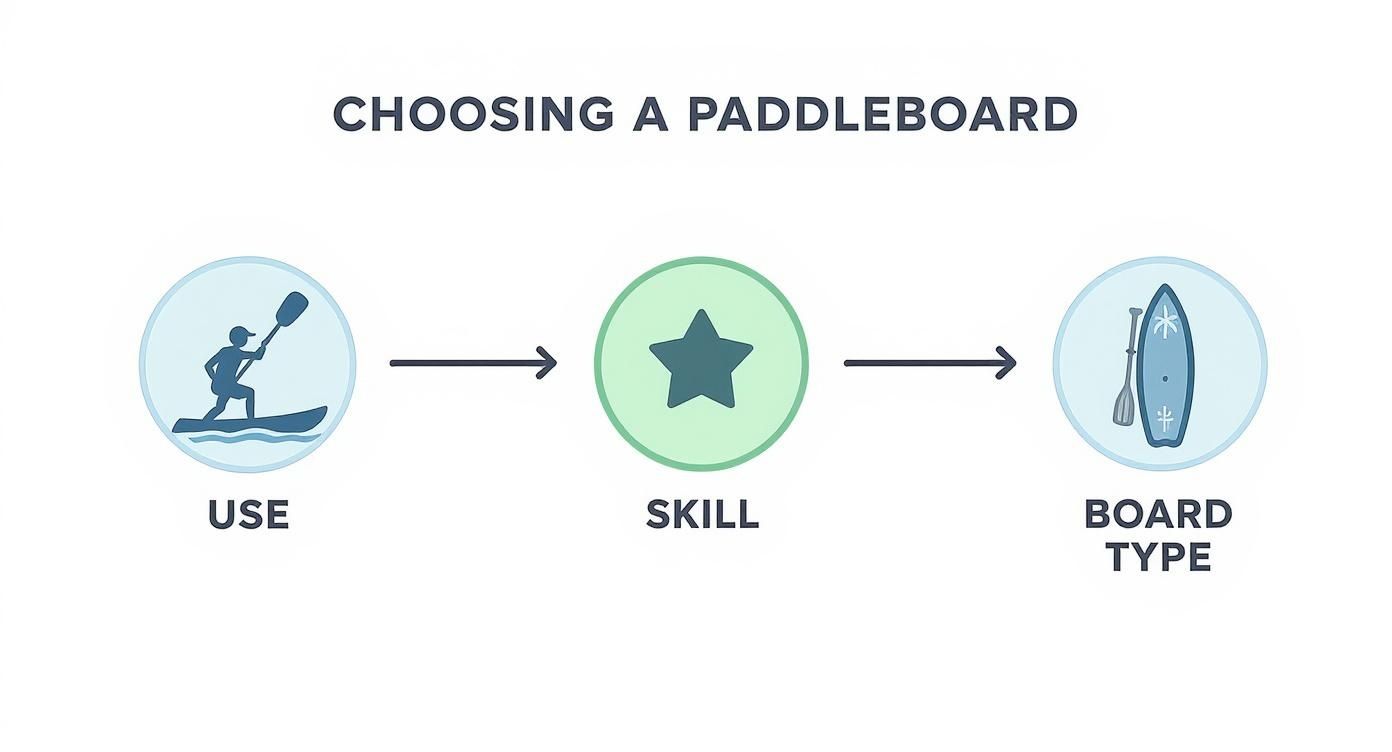
As you can see, a new paddler just looking for some general fun will naturally be guided towards a stable, all-round board—which is the perfect place to start.
At the end of the day, picking a paddleboard is a personal journey. The same principles apply to finding your perfect match in any activity, whether it's yoga or paddling. It’s about matching the gear to your goals.
To make things even clearer, I've put together a quick reference table. Use it to get a snapshot of which board might be right for you.
Quick Paddleboard Selection Guide
| Paddler Profile | Primary Use | Recommended Board Type | Key Features |
|---|---|---|---|
| Complete Beginner | All-round fun, recreational paddling | All-Round Inflatable (iSUP) | Wide, stable (32"+), durable, easy to transport |
| Intermediate Explorer | Day trips, long-distance paddling | Touring Board (Inflatable or Solid) | Pointed nose, longer (11'-12'6"), good glide |
| Wave Rider | SUP Surfing | Surf SUP (Solid) | Shorter, more manoeuvrable, rocker in the nose |
| Fitness Fanatic | Yoga, Pilates, on-water workouts | Yoga SUP | Wide and stable deck, full-length deck pad |
This table should give you a solid starting point. From here, you can dig deeper into the specific dimensions and features that will make your time on the water truly brilliant.
Inflatable vs Solid Boards: A Practical Decision
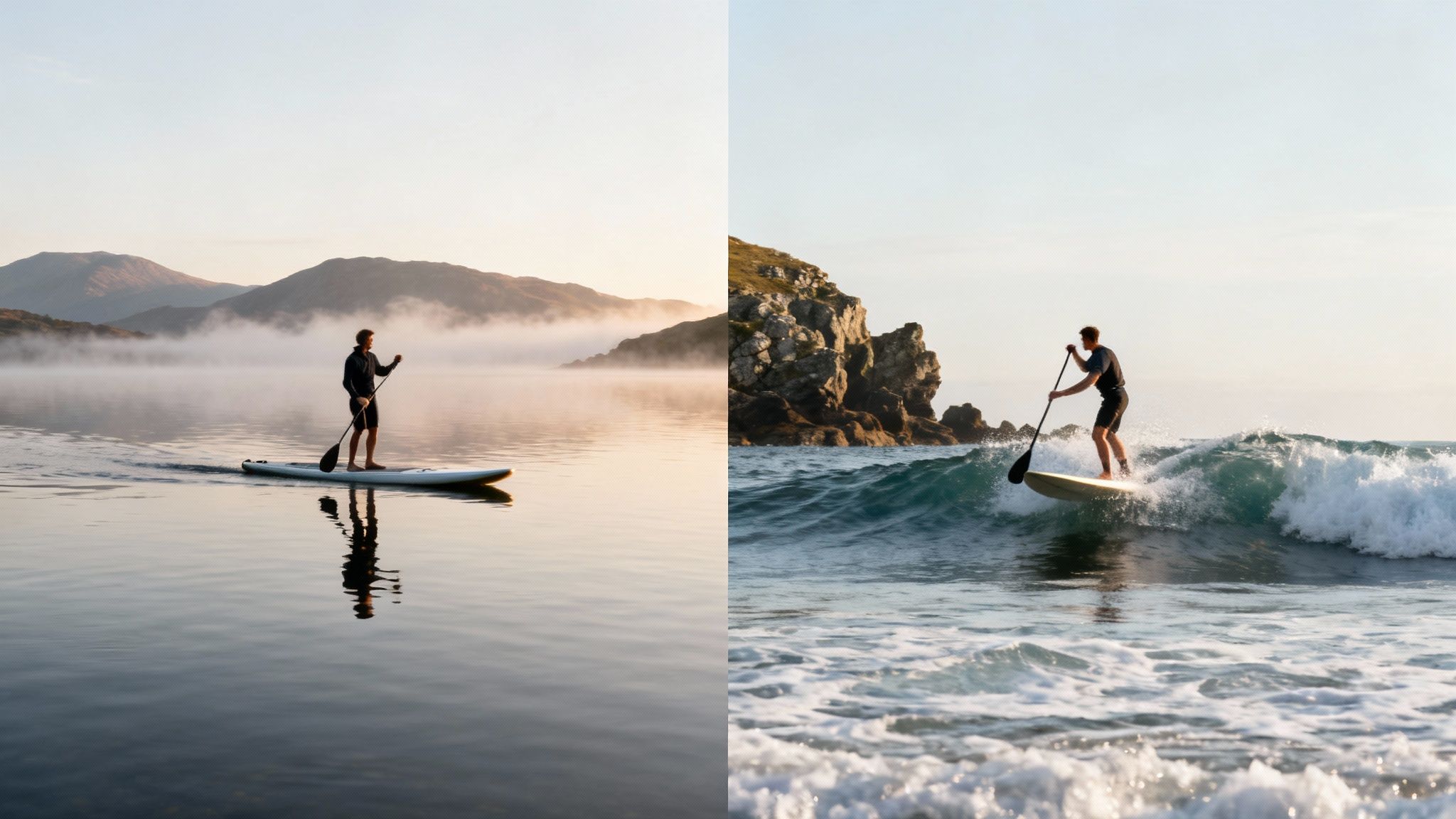
When you're figuring out how to choose the right paddleboard, the first big crossroads you'll hit is inflatable versus solid. This isn't just a minor detail; it's a choice that shapes everything from how you get to the water to how the board actually feels underneath your feet.
For most of us here in the UK, practicality often wins the day. Inflatable boards have absolutely taken over the market, and for good reason. Let's be honest, not many of us have a garage with acres of space, especially in cities. The ability to pack your board away into a cupboard is a game-changer.
The Case For Inflatable Boards
The sheer convenience of an inflatable SUP (or iSUP) is tough to beat. A quality iSUP like the Loco Amigo Air rolls up neatly into a backpack. That means you can chuck it in the boot of a Mini, carry it on your back down a winding coastal path, or simply stash it away when you're done. No roof rack, no problem.
And if you’re picturing a flimsy pool toy, think again. Modern inflatables are built differently. They use something called drop-stitch technology—thousands of tiny threads connecting the top and bottom surfaces. Once you pump it up to the recommended pressure, usually 15-20 PSI, it becomes surprisingly rigid and stable. For most paddlers, the on-water experience is fantastic.
They’re also incredibly tough. For example, bumping into a rock on a river or accidentally dropping an iSUP on the car park floor usually results in nothing more than a bounce. This makes them a brilliant choice for families with kids or anyone exploring rocky shorelines where a few knocks are inevitable.
For over 90% of recreational paddlers in the UK, an inflatable board is the most sensible choice. It's the ultimate grab-and-go solution, blending portability and durability with performance that gets better every year.
When To Choose A Solid Board
So, with all that going for inflatables, why would you ever go for a solid board? One word: performance.
As good as inflatables have become, a solid composite board gives you a more direct, connected feel on the water. This translates to better glide, more speed, and quicker responsiveness. It just feels more alive.
If you’re serious about SUP surfing, a solid board is really the only way to go. A practical example is that its thinner rails and refined shape let you carve on a wave with a precision an inflatable can't touch. Likewise, for dedicated racers or long-distance tourers, the efficiency of a hard board like the Loco Motion Pro cuts through the water with less effort, meaning you can cover more ground, faster.
Of course, there are trade-offs. You’ll need a garage or a big shed to store it, a roof rack to transport it, and you'll wince every time it gets a ding or scratch. For a more detailed look, our guide on why you might choose a hard board over an inflatable dives deep into the performance advantages.
Ultimately, it all boils down to your lifestyle and what you want to achieve on the water. Be honest with yourself and ask these questions:
- Storage: Where will it live? Do you have a garage, or is it destined for a cupboard under the stairs?
- Transport: Have you got a roof rack, or does it need to fit inside your car?
- Primary Use: Are you after chilled-out fun on the local canal, or are you looking to chase waves and smash personal bests?
Your answers will point you straight to the right type of board for your real-world adventures.
Decoding Board Dimensions For Your Best Ride
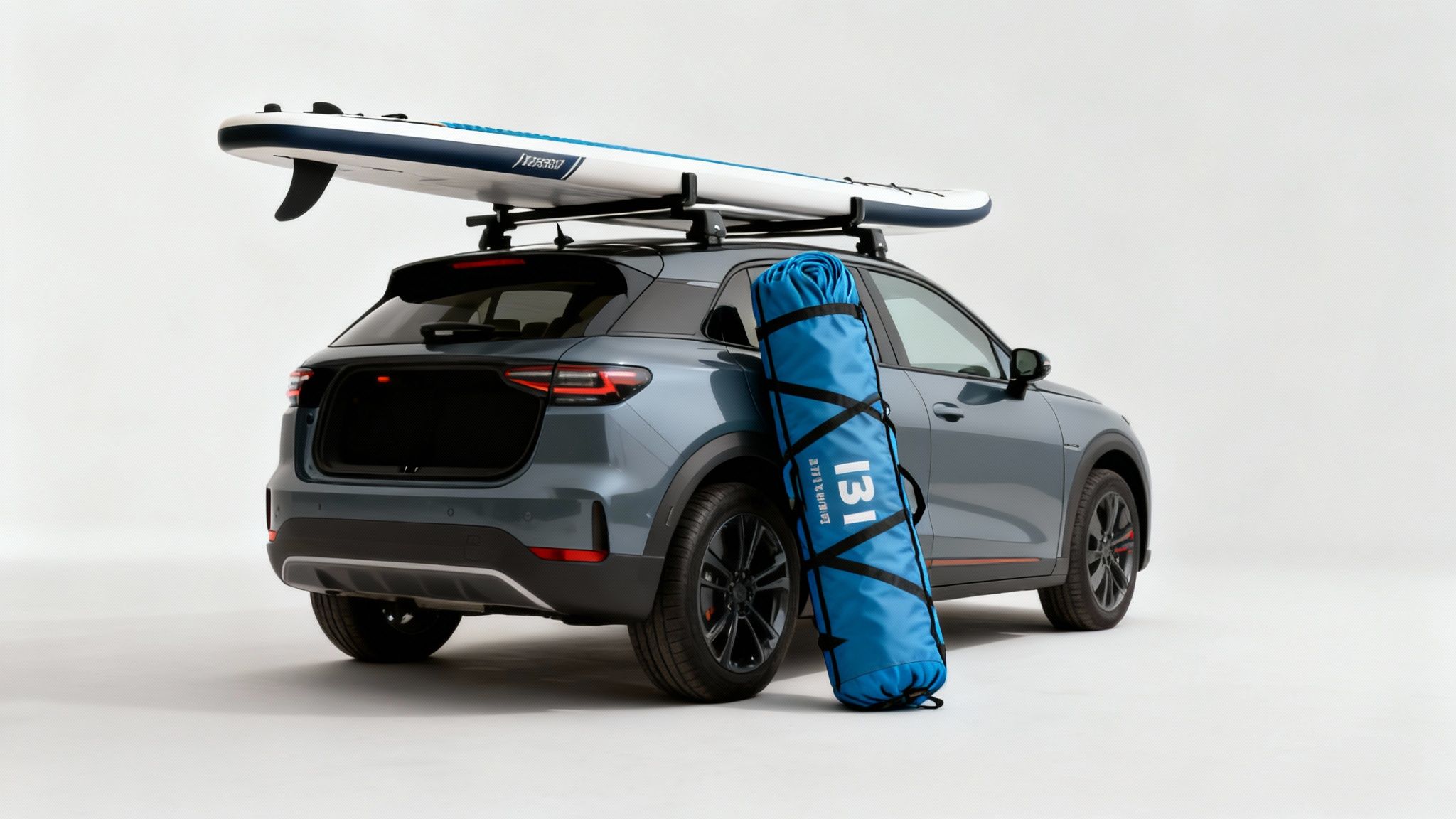
Once you’ve decided between an inflatable or a solid board, it’s time to get friendly with the numbers. The length, width, and volume on a spec sheet aren't just jargon for the pros; they're the DNA of your board, dictating exactly how it will feel and perform under your feet. Getting these dimensions right is a massive part of learning how to choose a paddleboard you’ll genuinely love paddling.
Each measurement plays a crucial role. When you understand how they all work together, you can pick a board that feels like it was made just for you, ensuring your time on the water is as fun and stable as possible.
Width: The Secret to Stability
For anyone just starting out, board width is your best friend. A wider board gives you a much more stable platform, which makes finding your balance a whole lot easier. This is precisely why most all-round boards designed for beginners, like the Loco Amigo Air, sit between 32 and 34 inches wide. That generous width gives you the confidence to stand up, paddle, and even try a few turns without feeling like you’re wobbling on a tightrope.
This extra stability is also brilliant for things like SUP yoga, or if you plan on bringing a child or your dog along for the ride. The trade-off? Wider boards are a touch slower and don't glide quite as smoothly as their sleeker cousins.
On the flip side, boards under 30 inches wide are all about speed. Racers and serious long-distance paddlers love these narrow designs because less width equals less drag. But that performance comes at a cost—a major drop in stability, making them a real handful for anyone but a seasoned paddler.
Length: For Tracking and Agility
Length has a direct impact on how a board moves through the water. Shorter boards, usually under 10 feet, are far more nimble and easier to turn. This agility is perfect for SUP surfing, where you need to make quick, sharp directional changes to catch and ride waves. A practical example would be a board from our Loco Surfs SUP range, which is shorter to allow for tighter turns on a wave face.
Longer boards, those over 11 feet, are built for touring and eating up the miles. Their longer waterline helps them track—that is, travel in a straight line—much more effectively. You’ll find you can get more paddle strokes in on one side before having to switch, which makes your paddling more efficient over distance. For instance, the Loco Motion Pro is a dedicated touring board designed to slice through the water and hold its course, mile after mile.
The most critical dimension is volume, measured in litres. It dictates how much weight a board can support while remaining stable and buoyant. A common mistake is choosing a board with too little volume for your body weight, which results in an unstable, submerged ride.
Volume: Your Personal Buoyancy Guide
Volume might just be the most important number of them all. It tells you how much weight the board can float, and it's directly linked to your own body weight. If the volume is too low, your board will sit deep in the water, feel incredibly wobbly, and be a real struggle to paddle. Go too high, and the board will feel corky and sluggish, a bit like trying to steer a giant barge.
Getting the volume right for your weight is essential for a good day out. For example, a 95kg paddler choosing a board with only 200L of volume would find it sits too low in the water, making it very unstable. They would be much better suited to a board with around 300L or more, which would provide adequate support and buoyancy.
In the meantime, here’s a handy table to give you a solid starting point.
Recommended Paddleboard Volume by Rider Weight
This table gives you a general idea of the volume you should be looking for, based on your weight and how comfortable you are on a board.
| Rider Weight (kg) | Beginner Volume (Litres) | Intermediate Volume (Litres) | Advanced Volume (Litres) |
|---|---|---|---|
| 50-70 kg | 180L - 240L | 150L - 200L | 120L - 170L |
| 70-90 kg | 240L - 300L | 200L - 260L | 170L - 220L |
| 90-110 kg | 300L - 350L+ | 260L - 320L | 220L - 280L |
Remember, this is a guide. If you're on the heavier side of a weight bracket or often paddle in choppy water, leaning towards the higher end of the volume range is always a good shout.
By balancing these three key dimensions—width for stability, length for performance, and volume for buoyancy—you’re well on your way to finding the perfect board.
How Board Shape Influences Your Paddling Style
Once you’ve got a handle on length and width, the next piece of the puzzle is the board's actual shape. The profile of the nose and tail, and the curve of the board from the side, are what really determine how it's going to feel under your feet. This is where you can dial in a board for exactly what you want to do, whether that's chilled-out lake cruising or getting a bit playful in the waves.
You'll mainly come across two distinct hull designs: planning hulls and displacement hulls. They're built for completely different jobs. A planning hull is what you see on most all-round boards – it’s flat and wide, designed to sit on top of the water.
The Versatile All-Rounder Shape
Picture that classic paddleboard with a rounded nose. That's the all-rounder. The shape creates a super stable and forgiving platform, which is perfect for beginners but still versatile enough for paddlers who want to dabble in a bit of everything. It’s the true jack-of-all-trades of the SUP world.
For instance, a board from the Loco Surfs SUP range is built with this versatile DNA. It gives you the stability you need for a gentle river paddle but has enough curve and responsiveness to be fun in small, mellow surf. This do-it-all attitude is precisely why they're so popular.
In fact, the rise in UK paddleboarding is closely tied to lifestyle trends focused on wellness and getting outdoors. Most people, especially younger and middle-aged paddlers, lean towards all-round boards between 10 and 11 feet long. They offer great stability on the flat water you find in most UK lakes and slow-moving rivers. Meanwhile, more seasoned paddlers tend to go for longer, more specialised boards for touring or racing. You can read the full research on SUP market trends to see how these preferences are shaping the industry.
The Efficient Touring and Race Shape
At the other end of the spectrum is the displacement hull. This design features a sharp, v-shaped nose that looks a lot like the bow of a kayak. Instead of riding on top of the water, it's designed to slice right through it.
This pointed nose cuts through chop and drastically reduces drag, letting the board glide further and faster with every single paddle stroke. This is the signature of ‘Touring’ and ‘Race’ boards. A practical example is paddling into a headwind: a touring board like the Loco Motion Pro will cut through the chop with ease, while an all-rounder with a planning hull would be pushed around more.
- Touring Boards: These use that pointed nose for pure efficiency on long journeys. They track straight, cover ground with less effort, and are built for mile-munching adventures.
- Race Boards: These push the displacement concept to its limits. They’re usually much narrower and are stripped down for raw speed, trading some stability for that winning edge.
Key Takeaway: The nose shape is your first clue to a board's purpose. A rounded, wide nose means versatility and stability (All-Round). A sharp, pointed nose means speed and efficiency (Touring/Race).
Understanding Rocker and Tail Shapes
Finally, take a look at the board from the side. The gentle upward curve from the middle to the nose and tail is called the rocker.
A board with more rocker—a more pronounced "banana" shape—will turn on a sixpence, which is brilliant for surfing. But that extra curve lifts more of the board out of the water, making it slower on the flat.
On the other hand, a board with a flatter rocker profile has more contact with the water. This helps it track in a straight line and glide more efficiently. The tail shape matters too. For example, a wide, squared-off tail on an all-round board like the Loco Amigo Air adds a dose of stability, whereas a tapered ‘pintail’ on a surf SUP gives you more grip and control when you’re carving a turn on a wave. Getting to grips with these details helps you find a board that truly fits your ambitions.
Essential Gear For Your First Outing
Once you've picked out the perfect board, it's time to think about the rest of your kit. Your paddleboard is the main event, of course, but the gear you pair it with is just as vital for your safety, performance, and how much fun you have on the water – especially here in the UK where conditions can flip in an instant.
Lots of beginner packages throw in an aluminium paddle, which is perfectly fine to get you started. But if you’re going to make one upgrade, make it the paddle. It's hands down the best investment you can make to improve your time on the water. A practical example is paddling for an hour: with a heavier aluminium paddle, your shoulders and arms will ache, but a lighter carbon paddle allows you to paddle for longer with significantly less fatigue.
Switching to a lighter carbon or fibreglass model is a complete game-changer. Suddenly, every stroke feels more efficient and powerful, letting you paddle further with way less effort. That means more time exploring and less time feeling wiped out.
Safety First Non-Negotiables
Beyond performance, some bits of kit are simply not optional. It doesn’t matter if you’re a seasoned pro or just starting out, you should never hit the water without these items. The UK's waters can be unpredictable, and being properly prepared is just part of being a responsible paddler.
- A Leash: This is your lifeline. Your board is a massive flotation device, and the leash keeps you attached to it if you fall in. Always, always wear one. The type matters, too – a coiled leash is best for flat water as it stays neatly on your deck, whereas a straight leash is better for surfing to stop the board pinging back at you in the waves.
- A Buoyancy Aid or PFD: A Personal Flotation Device (PFD) or buoyancy aid is a must, particularly if you're not a confident swimmer or you're paddling in chilly or challenging conditions. It gives you crucial support when you least expect it.
Investing in a quality paddle and the right safety equipment isn't an extra—it's a fundamental part of setting yourself up for success. It transforms your time on the water from a potential struggle into a genuinely brilliant experience.
Practical Kit for a Better Day Out
With the serious safety stuff sorted, a few other items will just make your paddle sessions that much more comfortable and hassle-free. These are the things that experienced paddlers rarely leave home without.
If you've got an inflatable board, a reliable dual-action iSUP pump is a must-have; it makes getting your board ready so much quicker. A good quality dry bag is also invaluable for keeping your phone, keys, and a spare layer of clothing bone dry.
For a deeper dive into paddles, check out our complete guide on selecting the perfect SUP paddle. It breaks down all the differences between materials and blade shapes so you can find the right one for you.
And finally, always check the weather forecast before you head out. A small waterproof phone case can be a lifesaver for this very reason. A little bit of planning with your gear means you can focus on the paddling, not on what you wish you'd brought with you.
Common Paddleboard Questions Answered
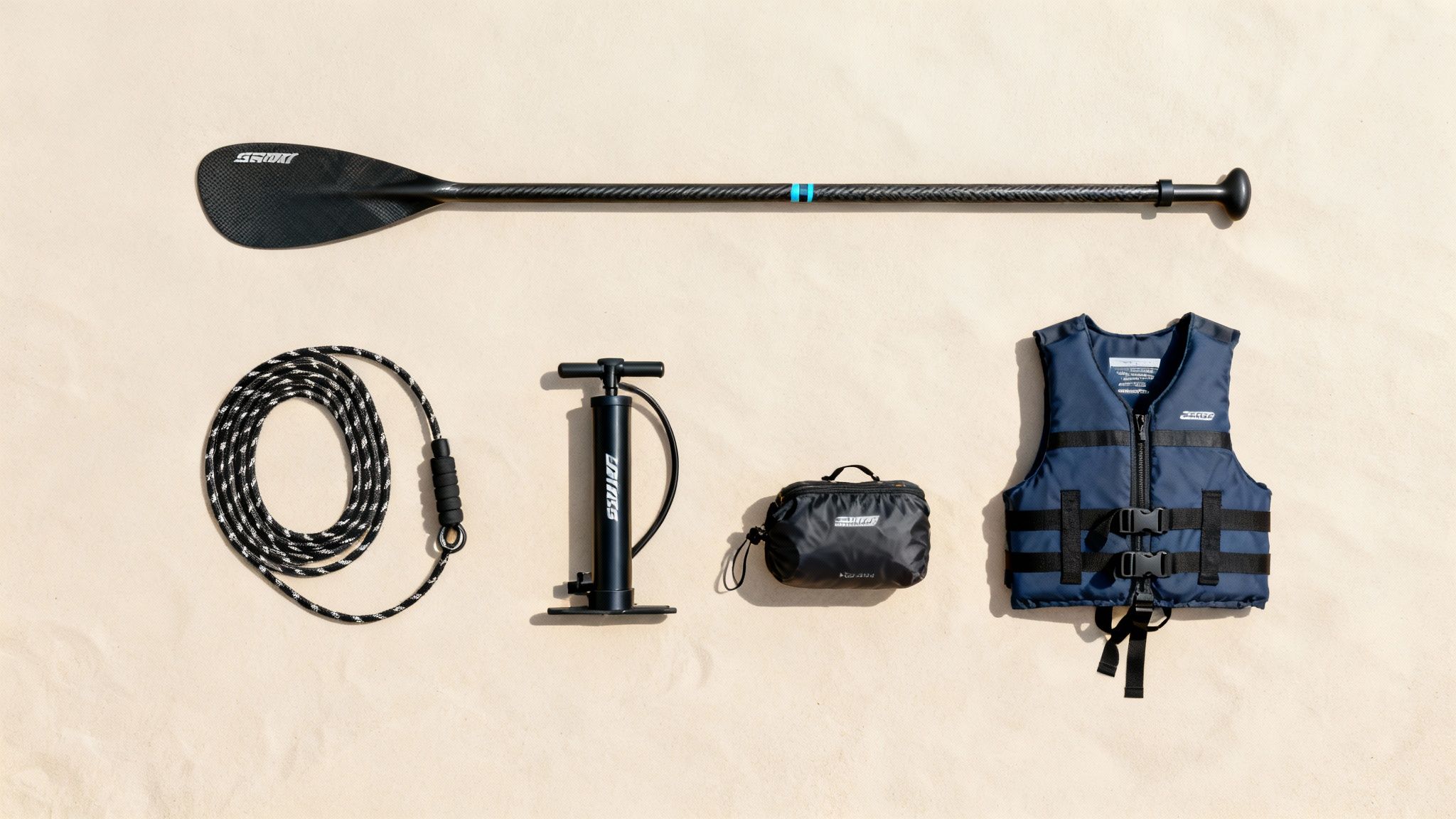
Alright, we've waded through the technical stuff – shapes, sizes, materials. But I know from experience that even after all that, there are usually a few nagging questions that can hold you back from making a final decision.
Think of this as a quick chat to clear up those last-minute uncertainties. We've pulled together the most common queries we get, so you can feel totally confident before you invest in your next board.
What Size Paddleboard Is Best For A Beginner?
When you're just starting out, your number one priority should be stability. Forget about speed for now. You're looking for an all-round board that’s about 10'6" in length and somewhere between 32-34 inches wide. That combination is the sweet spot for a stable platform, helping you find your feet and build confidence without constantly feeling wobbly.
Another crucial detail is the volume. Aim for a board with over 240 litres of volume, which will easily support an average-sized adult and stop you from feeling like you're half-submerged. A board like the Loco Amigo Air is a perfect real-world example; it's designed with exactly these friendly dimensions in mind, making it a brilliant first choice.
Is An Expensive Carbon Paddle Really Worth It?
The short answer is yes, absolutely. While you don’t need one for your very first paddle, upgrading from the heavy aluminium paddle that often comes in a package is the single best investment you can make. It's a hot topic in paddling circles and blogs like this one on how to choose the right SUP for you, and for very good reason.
A practical example of the difference is clear on a long paddle. After an hour, a heavy aluminium paddle can cause significant shoulder strain, whereas a lightweight carbon paddle feels effortless, allowing you to enjoy the scenery rather than focusing on muscle fatigue. It genuinely transforms your time on the water.
Think of a quality paddle not as an accessory, but as the engine for your board. A better engine makes any journey more enjoyable and efficient, regardless of the board you're on.
Can One Board Work For Both Flat Water And Surfing?
Definitely, but it’s all about accepting a compromise. This is where those versatile 'all-round' boards really shine – they're the Swiss Army knives of the paddleboarding world.
An all-rounder gives you enough stability for a chilled-out cruise on a lake, but it also has just enough rocker (that upward curve in the nose) and manoeuvrability to catch a few small, gentle waves. Of course, a dedicated surf SUP will always feel better in proper surf, but for someone wanting to dip their toe in everything, a versatile board in the 9'10" to 10'8" range is the perfect middle ground. The Loco Surfs SUP range is a great example of boards designed to handle these mixed conditions.
How Important Are The Fins On A Paddleboard?
Fins are vital. They're like the keel on a boat, keeping your board tracking straight and feeling stable underfoot. Without them, you’d just spin in circles.
Most all-round boards come with a three-fin 'thruster' setup. As a practical example, for paddling on a calm canal, you can get away with just using the large central fin to minimise drag and improve glide. But if you then take that same board to the coast where there's some chop, popping in the two smaller side fins will give you much-needed grip and control when you turn. Learning this simple adjustment can completely change how your board feels on any given day.
Ready to find the board that will elevate every second you spend on the water? The expert team at Loco Surfing is here to help you choose the perfect match from our range of performance-driven boards, designed right here in the UK. Explore our collection and start your adventure today.


